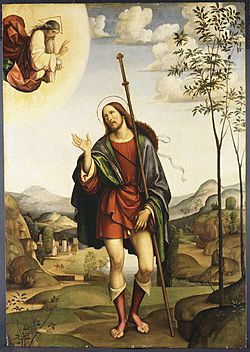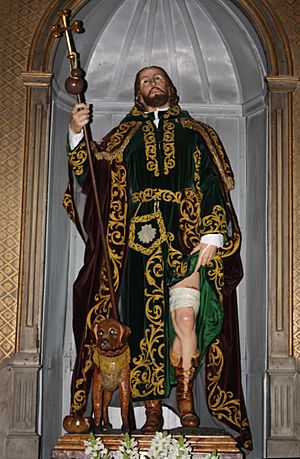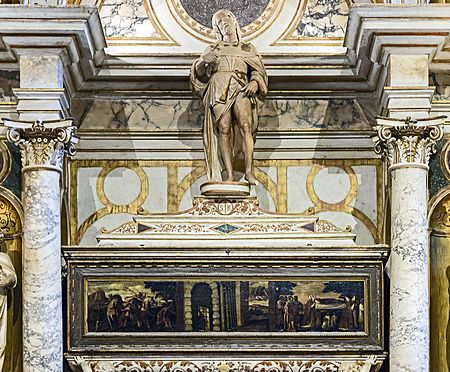Saint Roch facts for kids
Quick facts for kids SaintRoch |
|
|---|---|

Saint Roch by Francesco Francia
|
|
| Confessor | |
| Born | c. 1348 (trad. 1295) Montpellier, Kingdom of Majorca |
| Died | 15/16 August 1376/79 Voghera, County of Savoy (trad. 1327, Montpellier) |
| Venerated in | Catholic Church Anglican Communion Aglipayan Church |
| Canonized | by popular fervour; added to the Roman Martyrology by Pope Gregory XIV |
| Feast | 16 August 17 August (Third Order of Saint Francis) |
| Attributes | Wound on thigh, dog offering bread, Pilgrim's hat, Pilgrim's staff |
| Patronage |
|
Saint Roch (also called Rock in English) was a Catholic saint who lived in the 1300s. He is remembered on August 16 each year. People especially prayed to him for help during the plague, a terrible sickness that spread across Europe.
Saint Roch is known as a special helper, or "patron saint," for many groups. These include dogs, sick people, and those who have been wrongly accused. He is also the patron saint of several towns in Italy, Spain, and the Philippines. In different countries, his name changes. For example, he is "São Roque" in Portuguese and "San Roque" in Spanish.
Contents
The Story of Saint Roch

Saint Roch's life story has some parts that are like legends, so we don't know every detail for sure. He was born in Montpellier, a city that was then on the edge of France. His birth was seen as a miracle because his mother had not been able to have children until she prayed to the Virgin Mary.
From birth, Roch had a red cross on his chest that grew with him. He lived a very simple and religious life from a young age. When his parents died when he was about 20, he gave away all his money and belongings to the poor. He then became a traveling pilgrim who relied on charity, heading towards Rome.
Helping the Sick
While traveling in Italy, a terrible sickness called the plague was spreading. Roch spent his time helping sick people in hospitals in different cities like Acquapendente and Rome. People say he helped many get better through prayer and by touching them.
In Rome, a cardinal (a high-ranking church official) was saved when Roch made the sign of the cross on his forehead. This mark stayed there as a miracle.
Roch Gets Sick
Later, while helping people in Piacenza, Roch himself became sick with the plague. He went into a forest and made a small shelter from branches and leaves. A spring of water appeared there to help him. He might have died if not for a dog.
This dog belonged to a nobleman named Gothard Palastrelli. The dog brought Roch bread and licked his wounds, which helped them heal. Count Gottardo, following his hunting dog, found Roch and took him home to recover.
His Final Days
On his way back home to Montpellier, Roch was arrested in Voghera. He was thought to be a spy, even though he was arrested by orders from his own uncle, who didn't recognize him. He was put in prison and stayed there for five years. He died on August 16, 1327, without telling anyone his real name.
The people of the town later recognized him by the red cross birthmark on his chest. They quickly began to think of him as a saint, and a large church was built to honor him.
Honoring Saint Roch
Saint Roch became very popular, first in Italy and France, then spreading to Spain, Germany, and other countries. He was often included with other saints who were prayed to during the Black Death. In Venice, a special group called the Scuola Grande di San Rocco and a church were built for him. His body was said to have been brought to Venice in 1485. The Scuola Grande is famous for its paintings by Tintoretto, which include a painting of Roch.
It is known that Roch's body was moved from Voghera to Venice in 1485. Popes later built a church and hospital in his honor. In 1590, Pope Gregory XIV officially added Roch of Montpellier to the list of Catholic saints, setting August 16 as his special feast day.
Many groups have been formed to honor him. In art, he is usually shown wearing pilgrim clothes. He often lifts his tunic to show the plague sore on his thigh. A dog carrying bread in its mouth is usually with him.
Saint Roch received new attention and prayers during the COVID-19 pandemic.
Saint Roch in Art
After the Black Death, especially an Italian plague in the late 1400s, new artworks of Christian saints appeared. Roch became very famous. Religious art from that time showed how important the saint was to Christians suffering from the plague.
Paintings of Roch often showed him with symbols of the plague, like swords or arrows. They also showed reminders of death and dark clouds. The physical signs of the plague, like a raised arm or a collapsed body, also became symbols in these paintings.
Paintings of "plague saints" like Roch offered hope and healing. A special type of painting, called a "plague votive," was believed to protect against the plague. These paintings showed a saint acting as a go-between for God and the people who ordered the painting. These were often towns or groups trying to make up for their community's "sins."
These paintings show that people were taking action to feel more in control during the plague. Paintings of Roch show how much people in the Renaissance believed they could get help from above to overcome the plague's destruction.
In art after 1477, Roch is shown displaying his plague wound without showing pain. He actively lifts his clothes to show the plague sore on his thigh. This showed that he "welcomed his disease as a chance to be like Christ's sufferings." His patient way of dealing with the physical pain of the plague was seen as a type of martyrdom.
Roch's role as a pilgrim who suffered from the plague is very important in how he is shown in art. Seeing Roch scarred by the plague but still alive and healthy must have been a powerful image of a promised cure. He was proof that someone could survive the plague, a saint who had won against the disease in his own body.
Saint Roch in Books and TV
- In the book The Plague by Albert Camus, people in a cathedral are seen gathered around a statue of Saint Roch.
- In the book Doomsday Book by Connie Willis, a priest who helps plague victims is named Father Roche.
- A TV show from the Philippines in 2012, called Aso ni San Roque (which means Saint Roch's Dog), shows a dog from a statue of San Roque coming to life. This dog becomes the guardian of a blind girl.
See also
 In Spanish: Roque para niños
In Spanish: Roque para niños
- San Rocco, a Catholic church in Piacenza, Italy






